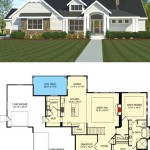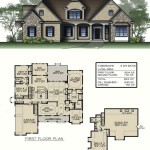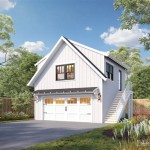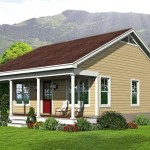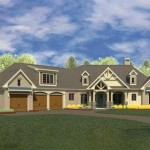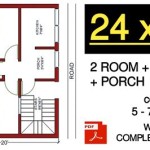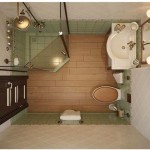Small House Plans With High Ceilings: Maximizing Space and Aesthetics
The appeal of small house plans is increasingly evident in contemporary residential design. Factors such as affordability, eco-consciousness, and a desire for simplified living have fueled this trend. However, the challenge lies in optimizing limited square footage to create a comfortable and visually appealing living environment. One solution gaining significant traction is incorporating high ceilings into small house plans. This architectural choice offers a multitude of benefits that extend beyond mere aesthetics, significantly impacting the perceived spaciousness and overall functionality of the dwelling.
High ceilings, defined as ceilings exceeding the standard eight-foot height, present a unique opportunity to transform a compact house into a space that feels considerably larger and more inviting. They contribute to improved natural light distribution, create a sense of vertical volume, and offer design flexibility that is often limited in conventionally proportioned small homes. This article explores the advantages of small house plans with high ceilings, examining the key design considerations, practical implications, and potential drawbacks associated with this architectural approach.
Enhanced Sense of Spaciousness
The most significant advantage of high ceilings in small house plans is the creation of an enhanced sense of spaciousness. Even in a modest square footage, higher ceilings visually expand the vertical dimension, making the rooms feel larger and more airy. This effect is achieved through several mechanisms. Firstly, the increased vertical distance between the floor and the ceiling reduces the feeling of confinement that can be prevalent in small spaces with standard ceiling heights. Secondly, the increased volume of the room allows for better airflow and ventilation, contributing to a more comfortable and breathable atmosphere. Thirdly, high ceilings provide a greater canvas for visual interest and strategic design elements, diverting attention from the limited floor area.
The psychological impact of high ceilings should not be underestimated. Humans generally perceive spaces with higher ceilings as being more open, grand, and inspiring. This can lead to a more positive and relaxed living experience. Conversely, lower ceilings can sometimes create a feeling of claustrophobia and restrictiveness, negatively impacting mood and overall well-being. In the context of a small house, where space is already limited, the psychological benefits of high ceilings are particularly valuable in mitigating the feeling of being cramped.
Furthermore, the increased vertical space allows for the incorporation of design features that would be impractical or impossible in a standard-height room. For instance, tall windows can be installed to maximize natural light penetration. Vertical storage solutions, such as floor-to-ceiling bookshelves or cabinets, can be implemented to efficiently utilize the available space. Decorative elements, such as chandeliers or tall artwork, can be deployed to create visual interest and draw the eye upwards, further enhancing the perception of height.
Improved Natural Light Distribution and Ventilation
Natural light is a crucial element in creating a comfortable and inviting living environment. High ceilings significantly improve natural light distribution by allowing sunlight to penetrate deeper into the interior of the house. The increased height provides more surface area for windows, particularly clerestory windows or transom windows, which can be strategically placed to capture sunlight from various angles throughout the day. These higher windows also offer increased privacy, as they are less likely to be obstructed by neighboring buildings or landscaping.
The benefits of enhanced natural light extend beyond aesthetics. Exposure to natural light has been linked to improved mood, increased productivity, and better sleep patterns. Furthermore, natural light can reduce the need for artificial lighting during the day, leading to energy savings and a lower carbon footprint. In a small house with limited window options, high ceilings provide a critical opportunity to maximize natural light intake and create a brighter, more welcoming atmosphere.
In addition to improved natural light, high ceilings also contribute to better ventilation. Warm air naturally rises, and the increased vertical space allows for better air circulation throughout the room. This can be particularly beneficial in warmer climates, where it can help to reduce the need for air conditioning. High ceilings can also accommodate ceiling fans, which can further enhance air circulation and improve energy efficiency. Strategic placement of windows at different heights can create a natural convection current, drawing cool air in from lower openings and allowing warm air to escape through higher openings.
The combination of improved natural light and ventilation creates a healthier and more comfortable living environment. Adequate natural light and fresh air are essential for maintaining a positive indoor air quality and reducing the risk of respiratory problems. In a small house, where indoor air quality can be compromised due to limited space and ventilation, high ceilings provide a valuable advantage in creating a healthier and more sustainable living space.
Design Flexibility and Vertical Expansion Possibilities
High ceilings offer a level of design flexibility that is often lacking in small houses with standard ceiling heights. The increased vertical space allows for a wider range of architectural and decorative options, enabling homeowners to personalize their living space and create a unique visual identity. Lofts, mezzanines, and elevated platforms are just a few examples of how high ceilings can be utilized to expand the living area and create distinct zones within a small house.
A loft space, for instance, can be used as a bedroom, home office, or recreational area, effectively adding square footage to the house without expanding the footprint. A mezzanine level can serve as a reading nook, a storage area, or even a guest bedroom, providing a secluded and comfortable space within the open-plan design. Elevated platforms can be used to create a sense of division between different areas of the house, such as the living room and the dining area, without the need for walls or partitions.
Furthermore, high ceilings provide an opportunity to incorporate unique architectural features, such as exposed beams, vaulted ceilings, or skylights. Exposed beams can add character and visual interest to the room, creating a rustic or industrial aesthetic. Vaulted ceilings can create a sense of grandeur and spaciousness, particularly in areas such as the living room or the master bedroom. Skylights can provide additional natural light and ventilation, while also offering a view of the sky.
The design flexibility offered by high ceilings extends to the choice of furniture and décor. Tall bookcases, large artwork, and dramatic lighting fixtures can be used to create a visually striking and personalized living space. Vertical shelving units can be used to maximize storage and display personal belongings, while also adding vertical interest to the room. The overall effect is a space that feels more open, airy, and well-designed, despite its limited square footage.
While high ceilings offer numerous advantages, there are also some potential drawbacks to consider. High ceilings can increase heating and cooling costs, as the larger volume of air requires more energy to maintain a comfortable temperature. This can be mitigated through proper insulation and energy-efficient windows. Furthermore, high ceilings can sometimes feel overwhelming or impersonal if not properly designed and decorated. It is important to choose furniture and décor that are appropriately scaled to the height of the room and to create a balance between open space and visual clutter.
Construction costs may also be slightly higher for houses with high ceilings, as additional materials and labor may be required. However, the long-term benefits of increased space, improved natural light, and enhanced design flexibility often outweigh the initial investment. Moreover, the added value of a home with high ceilings can potentially increase its resale value in the future. It is essential to carefully weigh the costs and benefits of high ceilings in the context of individual needs and budget.
In summary, the integration of high ceilings into small house plans offers a compelling solution for maximizing space, enhancing natural light, and creating a visually appealing living environment. While careful planning and design are essential to address potential drawbacks, the benefits of this architectural approach are undeniable. Small house plans with high ceilings represent a thoughtful and innovative approach to modern residential design, providing a pathway to comfortable and stylish living in a smaller footprint.

Small House Ch50 Home Plan Plans Budget

Cathedral Ceiling House Plans Small W High Ceilings

Small House Ch42 Plans Design

Small House Ch226 Design Bedroom Furniture

High Ceilings And Materials Are Prominent Design Elements In This New House

Cathedral Ceiling House Plans Small W High Ceilings

Small House Ch10 Plans Floor Modern

Small House Plan Ch226

Modern House Ch28 Small Plans Floor

Small House Plan Ch226


